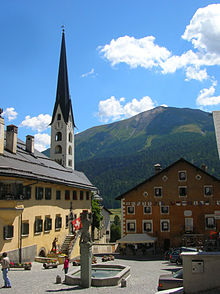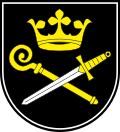Zuoz
| Zuoz | |
|---|---|
| State : |
|
| Canton : |
|
| Region : | Maloja |
| BFS no. : | 3791 |
| Postal code : | 7524 |
| Coordinates : | 793 239 / 164 077 |
| Height : | 1716 m above sea level M. |
| Height range : | 1657–3414 m above sea level M. |
| Area : | 65.78 km² |
| Residents: | 1186 (December 31, 2018) |
| Population density : | 18 inhabitants per km² |
| Website: | www.zuoz.ch |
|
Zuoz |
|
| Location of the municipality | |


Zuoz ( , dt. Obsolete: Zutz od. Zuz ) is a municipality in the Maloja region of the canton of Graubünden in Switzerland . Zuoz is the center of the historic La Plaiv landscape .
coat of arms
Blazon : In black a silver (white) sword with a golden (yellow) handle, crossed with a golden bishop's staff, topped with a golden crown .
The coat of arms is based on the old seal of the community, which shows St. Lucius with a crown and scepter. Instead of the figure, the crown and bishop's staff, the attributes of the saint, were chosen as a sign of his dual position as king and bishop, while the sword points to the old court tradition of the place.
population
| Population development | |||||||||||||
|---|---|---|---|---|---|---|---|---|---|---|---|---|---|
| year | 1781 | 1850 | 1900 | 1930 | 1941 | 1950 | 1960 | 2000 | 2005 | 2010 | 2012 | 2014 | 2016 |
| Residents | 378 | 423 | 425 | 969 | 693 | 779 | 1001 | 1353 | 1263 | 1310 | 1277 | 1244 | 1214 |
languages
The inhabitants mainly speak Puter (an idiom of Rhaeto-Romanic ) and German (Bündner dialect). In addition, there are Italian and Portuguese, languages of the immigrants living in Zuoz. Until well into the 19th century, all residents spoke Romansh. In 1880 it was 85%, in 1910 and 1941 56%. In 1970 and 1980 the municipality only had a (relative) Romansh-speaking majority (1970: 469 of 1165 inhabitants = 40%; 1980: see below). German has been gaining ground since the 1980s.
| Languages in Zuoz GR | ||||||
| languages | 1980 census | 1990 census | 2000 census | |||
| number | proportion of | number | proportion of | number | proportion of | |
| German | 457 | 38.53% | 547 | 45.62% | 720 | 53.22% |
| Romansh | 461 | 38.87% | 407 | 33.94% | 349 | 25.79% |
| Italian | 183 | 15.43% | 144 | 12.01% | 133 | 9.83% |
| Residents | 1186 | 100% | 1199 | 100% | 1353 | 100% |
Since, thanks to the school and community, 46% of the population can still speak Romansh, it is the only official language. Unofficially, however, German has the same status.
Religions and denominations
In 1554 the residents of the place converted to the Protestant faith.
Origin and nationality
Of the 1263 residents living in Zuoz at the end of 2005, 900 (= 71%) were Swiss citizens.
history
On the hill Chastlatsch (1,848 meters above sea level) was a Late Bronze Age and Iron Age settlement in the Laugen-Melaun culture . Zuoz was probably a late Roman and early medieval stage in the alpine network of trails.
In the Middle Ages, the Bishop of Chur owned the Dorta farm (today a part of the village) and the sovereignty of the Upper Engadin. 1137–1139 he acquired further property, a large farm and the church of St. Luzi (the large parish of La Plaiv ) from the south German Counts of Gamertingen . The parish church of St. Luzi was rebuilt around 1200, of which the ship and lower part of the tower have been preserved today. In 1244, Bishop Volkart appointed Andreas Planta von Zuoz as Chancellor of the Upper Engadin, thereby establishing the supremacy of the Planta family, which lasted until 1798. After 1288, the lower jurisdiction in the Upper Engadin was also in the hands of this Chur ministerial family until the beginning of the 16th century. In 1367 the Ammann Thomas Planta (Upper Engadine community seal) joined the Church of God . The ongoing disputes with Samedan led in 1438 to the division of the Upper Engadin judicial community - but not the high court - into the courts of Sur Funtauna Merla and Suot Funtauna Merla; the latter corresponded to the parish of La Plaiv. The first constitution of the judicial community is dated from 1462. The sale of the last episcopal income to the church was made in 1492. The parish church of St. Luzi was rebuilt late Gothic 1507 1438 Advanced second church of S. Caterina 1509. 1526 lost the bishop according to Ilanzer articles his Sovereign rights. During the Swabian War, the inhabitants set fire to their town-like patches to force the enemy to retreat. From the middle of the 15th century communalization started and S-chanf (1518), La Punt-Chamues-ch (1528) and Madulain (1534) dissolved.
The local humanist Gian Travers was the first political publicist to use the Upper Engadin language , the turkey, from 1527 onwards , and who also worked as a playwright. In 1534 his play “La Histoargia dal bio patriarch Josef” (= The life story of Patriarch Josef ) was premiered on the village square in Zuoz . Zuoz did not join the Reformation until 1554 ; Ulrich Campell from Susch was the first Protestant-Reformed pastor. Trade, transport and the conquest of Valtellina in 1512 led to an economic and spiritual boom, which manifested itself in the establishment of a Latin school, the aforementioned beginnings of a written Rhaeto-Romanic language, in religious and profane theater and in choral singing. Structural reflection of this development were the massive mansions and town houses, which at the same time remained farms. In addition to the old noble families von Planta, von Juvalta and Salis, a new ruling class, some of whom were ennobled by the emperor and who had become rich through trade and political offices, named Travers, Schucan, Raschèr, Jecklin, Wietzel, Danz and Geer.
Among the Grison turmoil 1618-1639 Zuoz suffered little, then began an economically induced migration. As a result of the loss of the Valtellina and the abolition of political privileges in 1798, Zuoz developed back into a simple farming village.
Even before the expansion of the valley road, which began in 1836, the road conditions in the Upper Engadin were quite good, but it was only the roads over the Albula Pass and the Flüela Pass that promoted the upswing. In 1903 it was connected to the Rhaetian Railway in Bever , and in 1913 the Bever-Zuoz- Scuol line was opened. Since 1900 the village has developed into a climatic health resort and economic center with the construction of hotels and the redesign of the former council inn . With the establishment of the Lyceum Alpinum in 1904, the opening of the Bellaria Hygienic School in 1909 and the joint secondary school for the Plaiv, the village became a regional school center. More hotels, holiday homes and ski lifts have been built since the 1950s and tourism has become increasingly important and is now the main industry. Agriculture, which had dominated up to now, experienced in the course of its mechanization a sharp reduction in farms and their relocation to the edge of the village. Empty stable barns were converted into apartments while preserving the historical village image. All families who had been resident for more than fifty years were granted municipal citizenship in 1980.
sport and freetime
Today Zuoz is an important tourist destination and is located on the route of the Engadine Ski Marathon . Zuoz has five ski lifts and a golf course. Numerous facilities for other sports are offered.
education
Zuoz is also known for the Lyceum Alpinum Zuoz , which was founded in 1904. It is a boarding school for 11 to 20 year old boys and girls, many of whom come from abroad.
Movie
- From Zuoz to Beijing. News from the global village. Reportage, Switzerland, 30 min., 2008, director: Christoph Müller, production: SF , Reporter series , first broadcast: February 6, 2008
Attractions
- Zuoz is one of the villages with the best preserved village center and numerous well-preserved buildings from the 16th century and earlier.
- In the center of the village is the Reformed Church of San Luzi . The Romanesque church of San Bastiaun is only rarely used for worship .
- In Zuoz, you will find Café Badilatti, the highest coffee roastery in Europe.
The following are also significant:
- Catholic Chapel of St. Catherine and Barbara
- Upper Planta House
- Lower planta house
- Tschudi Gallery = Tschudi or Chesa Madalena house, 2002, architect: Hans-Jörg Ruch
- Chasté sur En
- Chesa Am Lärchenhang '
- Chesa Bochert, in Brünaida
- Chesa Chastlatsch and renovation of Hotel Castell, 2004, Architects: Ben van Berkel , Walter Dietsche , Hans-Jörg Ruch
- Village tower (today district archive)
- House Poult
- Hotel Crusch Alva (White Cross)
- Hotel Castell, in Brunaida
- Inn Bridge
Personalities
- Johann Travers (1483–1563), lawyer and governor of Graubünden, military leader, pioneer and co-founder of the Rhaeto-Romanic language in the Upper Engadine
- Ulrich Campell (1510–1582), reformer, chronicler and hymn poet, 1554–1556 Evangelical Reformed pastor in Zuoz
- Jan Peider Danz (around 1575–1620), born and raised in Zuoz, reformed pastor in Celerina and Teglio, victim of the Veltliner murder
- Giörin Wietzel (1595–1670), governor of the Upper Engadin, politician and chronicler
- Lurainz Wietzel (1627–1670), lawyer and translator of the Geneva Psalter and pietistic edification literature into Ladin
- Petrus Domenicus Rosius à Porta (1734–1806), reformed pastor in Zuoz 1803–1806 and church historian
- Jakob von Albertini (1793–1848), politician
- Silvia Andrea (1840–1935), writer and translator
- Gian Casty (1914–1979), painter, illustrator and glass painter
- André Gorz (1923–2007), social philosopher and journalist, 1939–1941 student in Zuoz
literature
- Erwin Poeschel : The art monuments of the canton of Graubünden III. The valley communities Räzünser Boden, Domleschg, Heinzenberg, Oberhalbstein, Upper and Lower Engadine. (= Art Monuments of Switzerland. Volume 11). Edited by the Society for Swiss Art History GSK. Bern 1940. DNB 760079625 .
- Constant Wieser: Zuoz. In: Historical Lexicon of Switzerland . 2015 .
- Zuoz. The village, the houses and their former residents , Diego Giovanoli (author) with a family history excursion by Paolo Boringhierei, Chur 2005.
Web links
- Zuoz on the ETHorama platform
- Official website of the municipality of Zuoz
- Zuoz on elexikon.ch
Individual evidence
- ↑ Permanent and non-permanent resident population by year, canton, district, municipality, population type and gender (permanent resident population). In: bfs. admin.ch . Federal Statistical Office (FSO), August 31, 2019, accessed on December 22, 2019 .
- ↑ Constant Wieser: Zuoz. In: Historical Lexicon of Switzerland . 2015 .
- ↑ Constant Wieser: Travers, Johann. In: Historical Lexicon of Switzerland . 2014 .
- ↑ Constant Wieser: Zuoz. In: Historical Lexicon of Switzerland . 2015 .
- ^ Website Lyceum Alpinum . The story: Peter Metz: Schools on sunny heights . Chur: Tardis 2019, 163–186.
- ↑ OSEC ( page no longer available , search in web archives )
- ^ Catholic chapel of St. Catherine and Barbara
- ↑ Upper Planta House
- ↑ Lower Planta House
- ↑ Tschudi house
- ↑ Chesa Madalena
- ↑ Chasté sur En
- ↑ Chesa 'Am Lärchenhang'
- ↑ Graubünden - Building Culture | Buildings. Retrieved January 8, 2019 .
- ↑ Chesa Chastlatsch and renovation Hotel Castell
- ↑ Village tower (today district archive)
- ↑ House Poult
- ↑ Hotel Crusch Alva (White Cross)
- ^ Hotel Castell
- ↑ Inn Bridge








